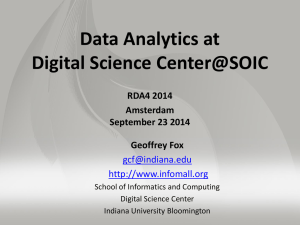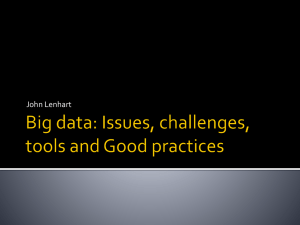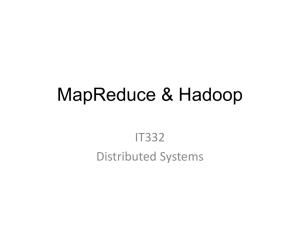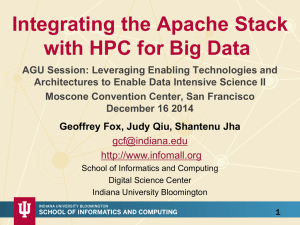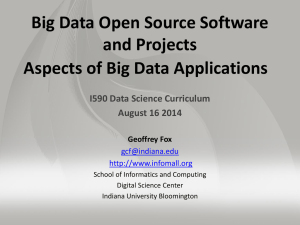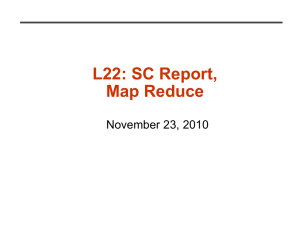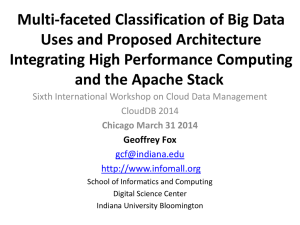Microsoft-April30-2014
advertisement
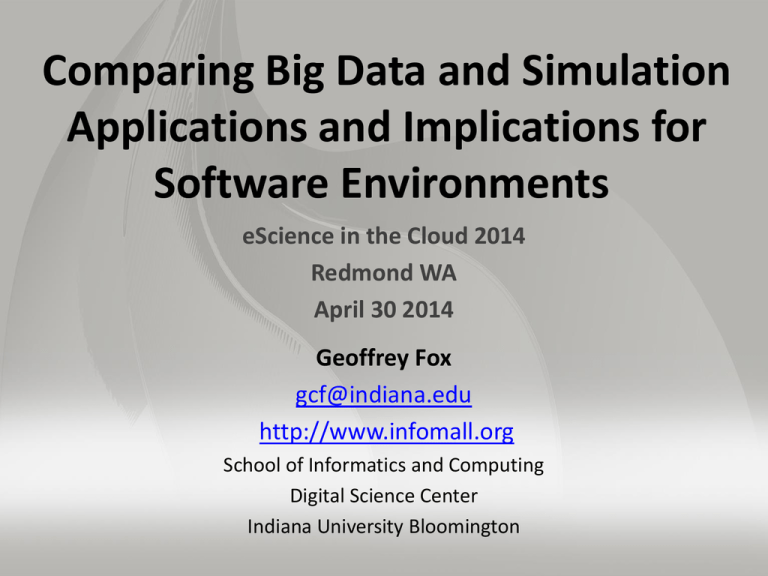
Comparing Big Data and Simulation Applications and Implications for Software Environments eScience in the Cloud 2014 Redmond WA April 30 2014 Geoffrey Fox gcf@indiana.edu http://www.infomall.org School of Informatics and Computing Digital Science Center Indiana University Bloomington Abstract • There is perhaps a broad consensus as to important issues in practical parallel computing as applied to large scale simulations; this is reflected in supercomputer architectures, algorithms, libraries, languages, compilers and best practice for application development. • However the same is not so true for data intensive, even though commercially clouds devote much more resources to data analytics than supercomputers devote to simulations. • We look at a sample of over 50 big data applications to identify characteristics of data intensive applications and to deduce needed runtime and architectures. • We suggest a big data version of the famous Berkeley dwarfs and NAS parallel benchmarks. • Our analysis builds on combining HPC and the Apache software stack that is well used in modern cloud computing. • Initial results on Azure and HPC Clusters are presented • One suggestion from this work is value of a high performance Java (Grande) runtime that supports simulations and big data NIST Big Data Use Cases Chaitin Baru, Bob Marcus, Wo Chang co-leaders Use Case Template • 26 fields completed for 51 areas • Government Operation: 4 • Commercial: 8 • Defense: 3 • Healthcare and Life Sciences: 10 • Deep Learning and Social Media: 6 • The Ecosystem for Research: 4 • Astronomy and Physics: 5 • Earth, Environmental and Polar Science: 10 • Energy: 1 4 51 Detailed Use Cases: Contributed July-September 2013 Covers goals, data features such as 3 V’s, software, hardware • • • • • • • • • • • 26 Features for each use case http://bigdatawg.nist.gov/usecases.php https://bigdatacoursespring2014.appspot.com/course (Section 5) Biased to science Government Operation(4): National Archives and Records Administration, Census Bureau Commercial(8): Finance in Cloud, Cloud Backup, Mendeley (Citations), Netflix, Web Search, Digital Materials, Cargo shipping (as in UPS) Defense(3): Sensors, Image surveillance, Situation Assessment Healthcare and Life Sciences(10): Medical records, Graph and Probabilistic analysis, Pathology, Bioimaging, Genomics, Epidemiology, People Activity models, Biodiversity Deep Learning and Social Media(6): Driving Car, Geolocate images/cameras, Twitter, Crowd Sourcing, Network Science, NIST benchmark datasets The Ecosystem for Research(4): Metadata, Collaboration, Language Translation, Light source experiments Astronomy and Physics(5): Sky Surveys including comparison to simulation, Large Hadron Collider at CERN, Belle Accelerator II in Japan Earth, Environmental and Polar Science(10): Radar Scattering in Atmosphere, Earthquake, Ocean, Earth Observation, Ice sheet Radar scattering, Earth radar mapping, Climate simulation datasets, Atmospheric turbulence identification, Subsurface Biogeochemistry (microbes to watersheds), AmeriFlux and FLUXNET gas sensors 5 Energy(1): Smart grid Part of Property Summary Table 6 10 Suggested Generic Use Cases 1) Multiple users performing interactive queries and updates on a database with basic availability and eventual consistency (BASE) 2) Perform real time analytics on data source streams and notify users when specified events occur 3) Move data from external data sources into a highly horizontally scalable data store, transform it using highly horizontally scalable processing (e.g. Map-Reduce), and return it to the horizontally scalable data store (ELT) 4) Perform batch analytics on the data in a highly horizontally scalable data store using highly horizontally scalable processing (e.g MapReduce) with a user-friendly interface (e.g. SQL-like) 5) Perform interactive analytics on data in analytics-optimized database 6) Visualize data extracted from horizontally scalable Big Data score 7) Move data from a highly horizontally scalable data store into a traditional Enterprise Data Warehouse 8) Extract, process, and move data from data stores to archives 9) Combine data from Cloud databases and on premise data stores for analytics, data mining, and/or machine learning 10) Orchestrate multiple sequential and parallel data transformations and/or analytic processing using a workflow manager 10 Security & Privacy Use Cases • • • • • • • • • • Consumer Digital Media Usage Nielsen Homescan Web Traffic Analytics Health Information Exchange Personal Genetic Privacy Pharma Clinic Trial Data Sharing Cyber-security Aviation Industry Military - Unmanned Vehicle sensor data Education - “Common Core” Student Performance Reporting • Need to integrate 10 “generic” and 10 “security & privacy” with 51 “full use cases” Big Data Patterns – the Ogres Would like to capture “essence of these use cases” “small” kernels, mini-apps Or Classify applications into patterns Do it from HPC background not database viewpoint e.g. focus on cases with detailed analytics Section 5 of my class https://bigdatacoursespring2014.appspot.com/preview classifies 51 use cases with ogre facets What are “mini-Applications” • Use for benchmarks of computers and software (is my parallel compiler any good?) • In parallel computing, this is well established – Linpack for measuring performance to rank machines in Top500 (changing?) – NAS Parallel Benchmarks (originally a pencil and paper specification to allow optimal implementations; then MPI library) – Other specialized Benchmark sets keep changing and used to guide procurements • Last 2 NSF hardware solicitations had NO preset benchmarks – perhaps as no agreement on key applications for clouds and data intensive applications – Berkeley dwarfs capture different structures that any approach to parallel computing must address – Templates used to capture parallel computing patterns • Also database benchmarks like TPC HPC Benchmark Classics • Linpack or HPL: Parallel LU factorization for solution of linear equations • NPB version 1: Mainly classic HPC solver kernels – MG: Multigrid – CG: Conjugate Gradient – FT: Fast Fourier Transform – IS: Integer sort – EP: Embarrassingly Parallel – BT: Block Tridiagonal – SP: Scalar Pentadiagonal – LU: Lower-Upper symmetric Gauss Seidel • • • • • • • • • • • • • 13 Berkeley Dwarfs Dense Linear Algebra First 6 of these correspond to Sparse Linear Algebra Colella’s original. Monte Carlo dropped. Spectral Methods N-body methods are a subset of N-Body Methods Particle in Colella. Structured Grids Unstructured Grids Note a little inconsistent in that MapReduce is a programming MapReduce model and spectral method is a Combinational Logic numerical method. Graph Traversal Need multiple facets! Dynamic Programming Backtrack and Branch-and-Bound Graphical Models Finite State Machines 51 Use Cases: What is Parallelism Over? • People: either the users (but see below) or subjects of application and often both • Decision makers like researchers or doctors (users of application) • Items such as Images, EMR, Sequences below; observations or contents of online store – – – – – • • • • • Images or “Electronic Information nuggets” EMR: Electronic Medical Records (often similar to people parallelism) Protein or Gene Sequences; Material properties, Manufactured Object specifications, etc., in custom dataset Modelled entities like vehicles and people Sensors – Internet of Things Events such as detected anomalies in telescope or credit card data or atmosphere (Complex) Nodes in RDF Graph Simple nodes as in a learning network Tweets, Blogs, Documents, Web Pages, etc. – And characters/words in them • Files or data to be backed up, moved or assigned metadata 14 • Particles/cells/mesh points as in parallel simulations 51 Use Cases: Low-Level (Run-time) Computational Types • PP(26): Pleasingly Parallel or Map Only • MR(18 +7 MRStat): Classic MapReduce • MRStat(7): Simple version of MR where key computations are simple reduction as coming in statistical averages • MRIter(23): Iterative MapReduce • Graph(9): complex graph data structure needed in analysis • Fusion(11): Integrate diverse data to aid discovery/decision making; could involve sophisticated algorithms or could just be a portal • Streaming(41): some data comes in incrementally and is processed this way (Count) out of 51 15 51 Use Cases: Higher-Level Computational Types or Features • • • • • Classification(30): divide data into categories S/Q/Index(12): Search and Query CF(4): Collaborative Filtering Local ML(36): Local Machine Learning Global ML(23): Deep Learning, Clustering, LDA, PLSI, MDS, Large Scale Optimizations as in Variational Bayes, Lifted Belief Propagation, Stochastic Gradient Descent, L-BFGS, Levenberg-Marquardt • GIS(16): Geotagged data and often displayed in ESRI, Microsoft Virtual Earth, Google Earth, GeoServer etc. • HPC(5): Classic large-scale simulation of cosmos, materials, etc. generates big data • Agent(2): Simulations of models of data-defined macroscopic entities represented as agents 16 Healthcare Life Sciences 18: Computational Bioimaging • Application: Data delivered from bioimaging is increasingly automated, higher resolution, and multi-modal. This has created a data analysis bottleneck that, if resolved, can advance the biosciences discovery through Big Data techniques. • Current Approach: The current piecemeal analysis approach does not scale to situation where a single scan on emerging machines is 32 TB and medical diagnostic imaging is annually around 70 PB even excluding cardiology. One needs a web-based one-stop-shop for high performance, high throughput image processing for producers and consumers of models built on bio-imaging data. • Futures: Goal is to solve that bottleneck with extreme scale computing with community-focused science gateways to support the application of massive data analysis toward massive imaging data sets. Workflow components include data acquisition, storage, enhancement, minimizing noise, segmentation of regions of interest, crowd-based selection and extraction of features, and object classification, organization, and search. Use ImageJ, OMERO, VolRover, advanced segmentation and feature detection software. Largely Local Machine Learning and Pleasingly Parallel 17 27: Organizing large-scale, unstructured collections of consumer photos I • Application: Produce 3D reconstructions of scenes using collections of millions to billions of consumer images, where neither the scene structure nor the camera positions are known a priori. Use resulting 3D models to allow efficient browsing of large-scale photo collections by geographic position. Geolocate new images by matching to 3D models. Perform object recognition on each image. 3D reconstruction posed as a robust non-linear least squares optimization problem where observed relations between images are constraints and unknowns are 6-D camera pose of each image and 3D position of each point in the scene. • Current Approach: Hadoop cluster with 480 cores processing data of initial applications. Note over 500 billion images on Facebook and over 5 billion on Flickr with over 500 million images added to social media sites each day. Global Machine Learning after Initial Local steps Deep Learning Social Networking 18 27: Organizing large-scale, unstructured collections of consumer photos II • Futures: Need many analytics, including feature extraction, feature matching, and large-scale probabilistic inference, which appear in many or most computer vision and image processing problems, including recognition, stereo resolution, and image denoising. Need to visualize large-scale 3D reconstructions, and navigate large-scale collections of images that have been aligned to maps. Global Machine Learning after Initial Local ML pleasingly parallel steps Deep Learning Social Networking 19 One Facet of Ogres has Computational Features a) b) c) d) e) f) g) h) Flops per byte; Communication Interconnect requirements; Is application (graph) constant or dynamic? Most applications consist of a set of interconnected entities; is this regular as a set of pixels or is it a complicated irregular graph? Is communication BSP or Asynchronous? In latter case shared memory may be attractive; Are algorithms Iterative or not? Data Abstraction: key-value, pixel, graph Core libraries needed: matrix-matrix/vector algebra, conjugate gradient, reduction, broadcast Data Source and Style Facet of Ogres • • • • • • • • • (i) SQL (ii) NOSQL based (iii) Other Enterprise data systems (10 examples from Bob Marcus) (iv) Set of Files (as managed in iRODS) (v) Internet of Things (vi) Streaming and (vii) HPC simulations (viii) Involve GIS (Geographical Information Systems) Before data gets to compute system, there is often an initial data gathering phase which is characterized by a block size and timing. Block size varies from month (Remote Sensing, Seismic) to day (genomic) to seconds or lower (Real time control, streaming) • There are storage/compute system styles: Shared, Dedicated, Permanent, Transient • Other characteristics are needed for permanent auxiliary/comparison datasets and these could be interdisciplinary, implying nontrivial data movement/replication Major Analytics Architectures in Use Cases • Pleasingly Parallel: including local machine learning as in parallel over images and apply image processing to each image - Hadoop could be used but many other HTC, Many task tools • Search: including collaborative filtering and motif finding implemented using classic MapReduce (Hadoop) • Map-Collective or Iterative MapReduce using Collective Communication (clustering) – Hadoop with Harp, Spark ….. • Map-Communication or Iterative Giraph: (MapReduce) with point-to-point communication (most graph algorithms such as maximum clique, connected component, finding diameter, community detection) – Vary in difficulty of finding partitioning (classic parallel load balancing) • Shared memory: thread-based (event driven) graph algorithms (shortest path, Betweenness centrality) 4 Forms of MapReduce (Users and Abusers) (a) Map Only Input (b) Classic MapReduce (c) Iterative Map Reduce (d) Point to Point or Map-Collective Input Input Iterations map map map Pij reduce reduce Output BLAST Analysis High Energy Physics Expectation maximization Classic MPI Local Machine Learning (HEP) Histograms Clustering e.g. K-means PDE Solvers and Pleasingly Parallel Distributed search Linear Algebra, PageRank particle dynamics MPI Domain of MapReduce and Iterative Extensions Giraph All of them are Map-Communication? 23 Core Analytics Facet of Ogres (microPattern) I Choose from Examples given here • Map-Only • Pleasingly parallel - Local Machine Learning • • • • • MapReduce Search/Query Summarizing statistics as in LHC Data analysis (histograms) Recommender Systems (Collaborative Filtering) Linear Classifiers (Bayes, Random Forests) • Map-Collective I (need to improve/extend Mahout, MLlib) • Outlier Detection, Clustering (many methods), • LDA (Latent Dirichlet Allocation), PLSI (Probabilistic Latent Semantic Indexing) Core Analytics Facet of Ogres (microPattern) II • • • • • • • • Map-Collective II Use matrix-matrix,-vector operations, solvers (conjugate gradient) SVM and Logistic Regression PageRank, (find leading eigenvector of sparse matrix) SVD (Singular Value Decomposition) MDS (Multidimensional Scaling) Hidden Markov Models Learning Neural Networks (Deep Learning) • Map-Communication • Graph Structure (Communities, subgraphs/motifs, diameter, maximal cliques, connected components) • Network Dynamics - Graph simulation Algorithms (epidemiology) • Asynchronous Shared Memory • Graph Structure (Betweenness centrality, shortest path) Comparison of Data Analytics with Simulation I • Pleasingly parallel often important in both • Both are often SPMD and BSP • Non-iterative MapReduce is major big data paradigm – not a common simulation paradigm except where “Reduce” summarizes pleasingly parallel execution • Big Data often has large collective communication – Classic simulation has a lot of smallish point-to-point messages • Simulation dominantly sparse (nearest neighbor) data structures – “Bag of words (users, rankings, images..)” algorithms are sparse, as is PageRank – Important data analytics involves full matrix algorithms “Force Diagrams” for macromolecules and Facebook Comparison of Data Analytics with Simulation II • There are similarities between some graph problems and particle simulations with a strange cutoff force. – Both Map-Communication • Note many big data problems are “long range force” as all points are linked. – Easiest to parallelize. Often full matrix algorithms – e.g. in DNA sequence studies, distance (i, j) defined by BLAST, Smith-Waterman, etc., between all sequences i, j. – Opportunity for “fast multipole” ideas in big data. • In image-based deep learning, neural network weights are block sparse (corresponding to links to pixel blocks) but can be formulated as full matrix operations on GPUs and MPI in blocks. • In HPC benchmarking, Linpack being challenged by a new sparse conjugate gradient benchmark HPCG, while I am diligently using nonsparse conjugate gradient solvers in clustering and Multidimensional scaling. HPC-ABDS Integrating High Performance Computing with Apache Big Data Stack Shantenu Jha, Judy Qiu, Andre Luckow • • • • HPC-ABDS ~120 Capabilities >40 Apache Green layers have strong HPC Integration opportunities • Goal • Functionality of ABDS • Performance of HPC Broad Layers in HPC-ABDS • • • • Workflow-Orchestration Application and Analytics: Mahout, MLlib, R… High level Programming Basic Programming model and runtime – SPMD, Streaming, MapReduce, MPI • Inter process communication – Collectives, point-to-point, publish-subscribe • • • • • • • • • In-memory databases/caches Object-relational mapping SQL and NoSQL, File management Data Transport Cluster Resource Management (Yarn, Slurm, SGE) File systems(HDFS, Lustre …) DevOps (Puppet, Chef …) IaaS Management from HPC to hypervisors (OpenStack) Cross Cutting – – – – Message Protocols Distributed Coordination Security & Privacy Monitoring Getting High Performance on Data Analytics (e.g. Mahout, R…) • On the systems side, we have two principles: – The Apache Big Data Stack with ~120 projects has important broad functionality with a vital large support organization – HPC including MPI has striking success in delivering high performance, however with a fragile sustainability model • There are key systems abstractions which are levels in HPC-ABDS software stack where Apache approach needs careful integration with HPC – Resource management – Storage – Programming model -- horizontal scaling parallelism – Collective and Point-to-Point communication – Support of iteration – Data interface (not just key-value) • In application areas, we define application abstractions to support: – Graphs/network – Geospatial – Genes – Images, etc. HPC-ABDS Hourglass HPC ABDS System (Middleware) 120 Software Projects System Abstractions/standards • Data format • Storage • • • • HPC Yarn for Resource management Horizontally scalable parallel programming model Collective and Point-to-Point communication Support of iteration (in memory databases) Application Abstractions/standards Graphs, Networks, Images, Geospatial …. High performance Applications SPIDAL (Scalable Parallel Interoperable Data Analytics Library) or High performance Mahout, R, Matlab… Iterative MapReduce Implementing HPC-ABDS Judy Qiu, Bingjing Zhang, Dennis Gannon, Thilina Gunarathne Using Optimal “Collective” Operations • Twister4Azure Iterative MapReduce with enhanced collectives – Map-AllReduce primitive and MapReduce-MergeBroadcast • Strong Scaling on K-means for up to 256 cores on Azure Kmeans and (Iterative) MapReduce Hadoop AllReduce 1400 1200 Hadoop MapReduce 1000 Time (s) Twister4Azure AllReduce 800 Twister4Azure Broadcast 600 400 Twister4Azure 200 HDInsight (AzureHadoop) 0 32 x 32 M 64 x 64 M 128 x 128 M Num. Cores X Num. Data Points 256 x 256 M • Shaded areas are computing only where Hadoop on HPC cluster is fastest • Areas above shading are overheads where T4A smallest and T4A with AllReduce collective have lowest overhead • Note even on Azure Java (Orange) faster than T4A C# for compute 37 Collectives improve traditional MapReduce • Poly-algorithms choose the best collective implementation for machine and collective at hand • This is K-means running within basic Hadoop but with optimal AllReduce collective operations • Running on Infiniband Linux Cluster Harp Design Parallelism Model MapReduce Model Architecture Map-Collective Model Application M M M Map-Collective Applications M M M M M Collective Communication Shuffle R MapReduce Applications R Harp Framework MapReduce V2 Resource Manager YARN Features of Harp Hadoop Plugin • Hadoop Plugin (on Hadoop 1.2.1 and Hadoop 2.2.0) • Hierarchical data abstraction on arrays, key-values and graphs for easy programming expressiveness. • Collective communication model to support various communication operations on the data abstractions • Caching with buffer management for memory allocation required from computation and communication • BSP style parallelism • Fault tolerance with checkpointing WDA SMACOF MDS (Multidimensional Scaling) using Harp on Big Red 2 Parallel Efficiency: on 100-400K sequences next move to Azure (Nodes: 8, 16, 32, 64, 128, JVM settings: -Xmx54000M -Xms54000M -XX:NewRatio=1 XX:SurvivorRatio=18) 1.20 1.00 0.80 0.60 100k 300k 0.40 0.20 200k 400k 0.00 0 20 40 60 80 100 Number of Nodes Conjugate Gradient (largest) and Matrix Multiplication 120 140 Mahout and Hadoop MR – Slow due to MapReduce Python slow as Scripting Spark Iterative MapReduce, non-optimal communication Harp Hadoop plug in with ~MPI collectives MPI fast as C, not Java Increasing Communication Identical Computation Spare Slides Application Class Facet of Ogres • • • • • • • • • • • • Source of Problem Search and query Maximum Likelihood or 2 minimizations Expectation Maximization (often Steepest descent) Global Optimization (such as Learning Networks, Variational Bayes and Gibbs Sampling) Do they Use Agents, as in epidemiology (swarm approaches)? Core Algorithmic Structure Basic Machine Learning (classification) Stochastic Gradient Descent SGD (L-)BFGS approximation to Newton’s Method Levenberg-Marquardt solvers Are data points in metric or non-metric spaces? Problem Architecture Facet of Ogres (Meta or MacroPattern) i. Pleasingly Parallel – as in BLAST, Protein docking, some (bio-)imagery including Local Analytics or Machine Learning – ML or filtering pleasingly parallel, as in bioimagery, radar images (pleasingly parallel but sophisticated local analytics) ii. Classic MapReduce for Search and Query iii. Global Analytics or Machine Learning seen in LDA, Clustering, etc., with parallel ML over nodes of system iv. SPMD (Single Program Multiple Data) v. Bulk Synchronous Processing: well-defined computecommunication phases vi. Fusion: Knowledge discovery often involves fusion of multiple methods. vii. Workflow (often used in fusion) Performance on Madrid Cluster (8 nodes) K-Means Clustering Harp vs. Hadoop on Madrid Increasing 1600 Identical Computation 1400 Communication Execution Time (s) 1200 1000 800 600 400 200 0 100m 500 10m 5k 1m 50k Problem Size Hadoop 24 cores Harp 24 cores Hadoop 48 cores Harp 48 cores Hadoop 96 cores Harp 96 cores Note compute same in each case as product of centers times points is identical

